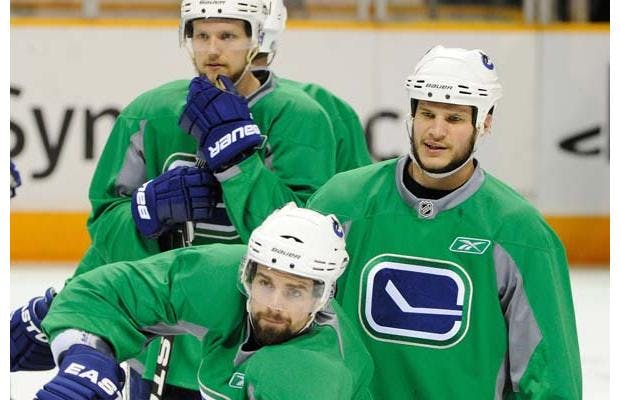The Committee That Replaced Ehrhoff’s Offense

Just prior to July 1st 2011, when it became apparent that he wasn’t willing to take a haircut to stay with the team, the Canucks traded Christian Ehrhoff’s right for a fourth round pick (which Gillis would later parlay into Samme Pahlsson). Ehrhoff would eventually sign with Terry "Rich Uncle Pennybags" Pegula’s Buffalo Sabres for forty million dollars, ten million of which was paid to him this season.
To replace Christian Ehrhoff’s steady, minute-eating presence on the back end, Gillis… Well he didn’t really do anything. The only new addition the Canucks made to their main clubs blueline this offseason was to add depth defenseman Alexander Sulzer, who may have replaced Ehrhoff in terms of the team’s "German National quotient," but was never expected to replace Ehrhoff’s offense, or fill the ‘Hoff’s top-four spot on the depth chart.
Despite the loss of Christian Ehrhoff – a fifty point defenseman in his final season in Vancouver, and undoubtedly a slick offensive talent – the Canucks blueline group managed to produce more offense this season than they did the season previous. Like the Reign of Terror stage of the French Revolution, the spike in the Canucks back-end offensive production this season was managed by committee.
Click past the jump for more!
Back-end production isn’t the best way to evaluate defenseman (obviously) but since Gillis’ arrival in Vancouver, he’s spoken often about the "goal" of icing a back-end that would produce 200 combined points in a season. It’s a lofty goal, and one none of Gillis’ clubs have yet accomplished. In both of his first two seasons as General Manager, the club managed a shade over 170 points, while last season (by far the club’s most successful of the Gillis era) the team’s defenseman combined to produce 157 points. This season, Canucks defenseman were the closest they’ve been to 200 during Gillis’ tenure, with 181 total points.
If you’re reading closely you already know that in the team’s first season since Ehrhoff’s departure (and without really bothering to replace his presence in the top-4) Canucks defenseman, as a group, produced 24 points more than they had in the ‘Hoff’s final season in Vancouver. At least in terms of offensive production, Henrik Sedin’s preseason declaration that the team wouldn’t miss Ehrhoff in the slightest is looking pretty accurate.
Let’s delve into the numbers somewhat, and see what we can see. Generally speaking, the spike in offensive production from the Canucks back-end was driven at even-strength where Vancouver’s blue-liners accumulated 119 even-strength points compared to last seasons 95. On the power-play, Canucks defenders contributed two fewer points (61 PP points in 2010-11, 59 this season) which, is certainly less of a drop off than most observers expected. In a curious quirk, while the club’s overall back-end production ticked up significantly at evens, Canucks defenseman’s combined goals-for totals dropped by four this season (from 27 to 23) but increased slightly with the man-advantage (from 15 last season, to 16 this season).
There’s still not much doubt that Ehrhoff is missed on the power-play, (even if Ehrhoff misses the Canucks, more than they miss him). Ze fleet-footed German’s absence is also felt in terms of Vancouver’s right-side depth, and an injury to Sami Salo (not exactly a far-fetched scenario) would leave the team with one of either Chris Tanev or Aaron Rome in the top-four. Frankly, neither scenario is ideal. But in terms of production, the Canucks core group (and their top-three guys in particular) successfully stepped up this season and managed to more than off-set the loss of Christian Ehrhoff.
Alex Edler may have produced fifty points and won the Babe Pratt (awarded for being a staple on the first power-play unit, apparently), but no one did more to help offset Ehrhoff’s loss this season than the man with the sneering veneer. Despite the constant nay-saying of many Canucks fans (and based on the Province.com’s player raters, it may even be "a majority of Canucks fans"), mean-mugging Kevin Bieksa has quietly put together a "career year" in Vancouver this season.
Occasionally, Kevin Bieksa’s decision making with the puck is questionable, and certainly he’s more likely to find himself in a spin cycle than his usual defensive partner, the preternaturally steady Dan Hamhuis. Still, Bieksa’s steady two-way performance this season has been essential to the club’s return to the top of the table and their spike in back-end production. While continuing to play (and dominate possession) against the opposition’s top-forwards, Bieksa also stepped up offensively and was second in the NHL in even-strength production (behind only sure-fire Norris nominee Erik Karlsson). The best part is that Bieksa’s 15 point spike in even-strength production doesn’t appear to be percentage driven (based on his on-ice and personal shooting percentage).
Between Bieksa, Hamhuis and Edler, the Canucks were one of only two NHL teams to boast three defenseman among the top-20 blueliners in even-strength production (2nd, 10th and 20th). Last season, they didn’t have a single defenseman in the top-30. While much has been, and continues to be made of Ehrhoff’s loss – in terms of the single biggest asset Ehrhoff contributed to the club (his offense), it appears that his absence has been quite thoroughly mitigated by the team’s remaining core defenseman. Some fans and media believed that cleaving Ehrhoff from the roster would be a rather significant blow, but ultimately it turned out to be just a flesh wound.
Recent articles from Thomas Drance





